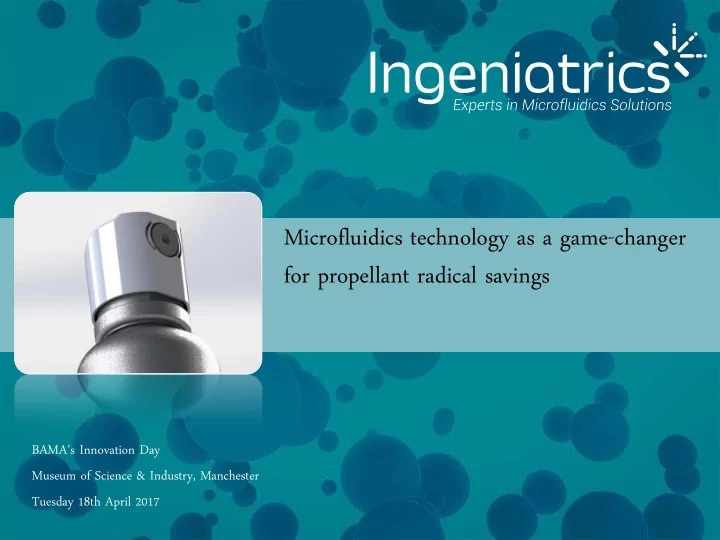

Microfluidics technology as a game-changer for propellant radical savings BAMA’s Innovation Day Museum of Science & Industry, Manchester Tuesday 18th April 2017
Table of Contents 1. Company Introduction 2. Microfluidics solutions approach to Aerosols 3. Bench test results 4. Conclusions 5. Next steps: Industrialization
1. Company Introduction
Company +18 permanent jobs Fluids Mechanics Research Privately funded IP (+100 patents) 2001 Quality Certified Free microjet generation technologies R&D +90% international clients Three business lines: • Industrial Innovation • Analytical Chemistry Nebulizers • Microencapsulation 4
Company Micro-Encapsulation Industrial Innovation Analytical Chemistry Microencapsulation Technologies Sample Introduction Nebulizers Innovative Industrial Devices Design + Prototyping + Manufacturing On demand services Aerosol Actuators OneNeb series Processes development New developments Omnidirectional Inket printing Small specialty particles Robotized applications production High Viscosity Spraying Fuel Injections and Micromixers Probiotics Evaporative Cooling Living organisms 5 Essential Oils
2. Microfluidics approach
Approach Laminar r Microjets Dripping Micro sprays Microencapsulation Gas - GLR extreme liquid uid effects Hybrid id options ions in the middl dle - Micro sprays, Microencapsulation A.M Gañán-Calvo App. Phys. Lett . 2005 , 86 , 214101 Turb rbulent ulent Micro sprays Microencapsulation + GLR Ingeniatrics’ expertise is the aerodynamic control of the aerosol generation 7
Approach • Can this be useful ful to the Aerosol industry? • What are the Aerosol’s Indu dustry stry challe lenge nges? Envir ironm onmenta ntal l and regula lator tory (Air as a propellant) **GLR** Packaging ging cost (less materials, optimal amounts of formula and gas) Safety ty (droplet size, high pressure vessels, inflammable gases) + all the specific challenges of every specific formulation and packaging (materials compatibility, stability…) - Not clogging gging - Effective and safe drople plet t size - Spray pattern
Approach • Can this be useful ful to the Aerosol industry? • What are the Aerosol’s Indu dustry stry challe lenge nges? “The less propellant the better” i.e. the lower GLR as possible 𝐻𝑀𝑆 = 𝑛 𝑛 𝑚
3. Bench test results
Bench test results Test1. . Test2. . Water Water-Et Ethano hanol l + Air HairSpra pray + + Isobuta utane • • 80/20 volume 803,1 Kg/m3 Kg/m3 • • 957,8 Kg/m3 3,6 cP • • 1,02 cP 22,19 mN/m suface tension • 30 mN/m suface tension Bench tests 06 * GLR 0,206 GLR 0,128 28 * Calculated Ql (ml/min) Qg (l/min) Δp (mbar) X50 (µm) GLR 10 2.12 800 18.15 0.265 15 2.09 800 21.21 0.175 20 2.04 800 24.13 0.128 Δp (mbar) Ql (ml/min) Qg (l/min) X50 (µm) GLR 10 2.05 800 18.89 0.449 15 2.02 800 20.98 0.287 20 1.99 800 23.34 0.206
Bench test results Bench tests
Bench test results Flow Rate vs Partic icle le Size ∆ P = 0,8 bar Test1. . Water Water-Et Ethano hanol l + Air le size μ m Particle
Bench test results Flow Rate vs Partic icle le Size ∆ P = 0,8 bar 10 ml/min Blue Test2. . 15 ml/min Red 1.4 20 ml/min Green HairSpra pray + + Isobuta utane 1.2 Test1. . Water Water-Et Ethano hanol l + Air 1.0 • 80/20 volume • 0.8 957,8 Kg/m3 • 1,02 cP • 30 mN/m suface tension 0.6 0.4 0.2 1 5 10 50 100 500 le size μ m Particle
Bench test results Gas pressu sure vs Particle icle Size Q = 20 ml/min Test1. . Water Water-Et Ethano hanol l + Air
Bench test results Gas pressu sure vs Particle icle Size Q = 20 ml/min 1.4 Test2. . Blue 700 mbar X50=23,67 µ m HairSpra pray + + Isobuta utane Red 800 mbar X50=21,99 µ m 1.2 Green 900 mbar X50=20,69 µ m Grey 1000 mbar X50=19,56 µ m 1.0 0.8 0.6 0.4 0.2 1 5 10 50 100 500
4. Conclusions
Conclusions We can get an excellent quality aerosol with a low gas consumption (GLR 0,128) just using the right nozzle technology (pneumatic) Formula flowrate and particle distribution are related (20ml/min good starting point) Gas pressure at the nozzle can be pretty low (0,9 bar) How ow wou ould th this s resul ult t on on a real l aeros osol ol can? • Smaller can • Use of Non- • Less propellant liquefiable propellants
Conclusions 𝐻𝑀𝑆 = 𝑛 Product Propellant Proportion GLR Hair spray Liquefied Formula:50% 𝑛 𝑚 1,11 Deodorant Liquefied Formula:20% 3,6 Moisturizer Compressed gas Formula:99,83% 0,002 How much formula can For a 100ml can, how How big should a can be be delivered with a 120ml much Isobutane do I to spray the same can and a 12g CO2 need in order to deliver amount of formula (48ml) cartridge as a propellant? 48ml of formula? but with compressed air? HairSpray + CO2 HairSpray + Isobutane HairSpray + Air Packaging Volume (ml) 100 100 436 used (ml) 108 83 436 Amount of propellant in can (g) 12 10 5 volume propellant in can, 25ºC,1atm, (ml) 18 17 olume of propellant, under pressure (ml) 35 388 % formula actually sprayed 90% 90% 90% targetted Formula flowrate (g/s) 0,3 0,3 0,3 Propellant requiered flowrate (g/s) 0,056 0,083 0,041 total spray flowrate (g/s) 0,356 0,383 0,341 Spraying time (s) 216 116 116 GLR (theoretical) 0,185 0,276 0,136 volume of formula delivered (ml) 81 43 43 volume of formula in the can (ml) 90 48 48 manometric pressure in the can (bar) 12,0 3,4 12,0 Comparative propellant savings 83% 75% 88%
Spraying time comparison 216 CO2 (120ml) 116 Isobutane (100ml) 116 Air (500ml) 20
5. Next steps. Industrialization
Industrialization
Industrialization
Thanks P.I. Parque Plata. C/ Camino Mozárabe, 41 41900 Camas, Seville (Spain) T.(+34)954081214 E.info@ingeniatrics.com www.ingeniatrics.com
Recommend
More recommend